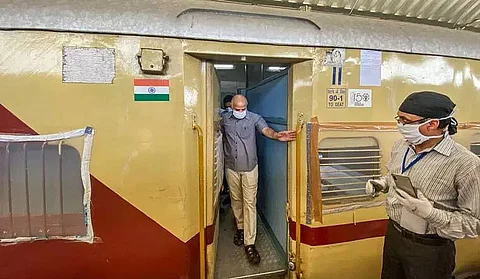
- Home
- Live Blog
- Breaking News
- Top Headlines
- Cities
- NE News
- Sentinel Media
- Sports
- Education
- Jobs

LONDON: Next time you are travelling via train, make sure your seat location, travel time and social distancing is just right to minimise infection if a COVID-19 patient is present in the coach.
Scientists from the University of Southampton and colleagues have for the first time detailed the chances of catching COVID-19 in a train carriage carrying an infectious person.
The 'attack rate' for each seat — the number of passengers in a given seat diagnosed with COVID-19, divided by the total number of passengers travelling in the same seat — increased by 0.15 per cent for every hour that a person travelled with an infected patient.
For those in adjacent seats, this rate of increase was higher at 1.3 per cent per hour.
Interestingly, the researchers found that only 0.075 per cent of people who used a seat previously occupied by an infected patient went on to contract the disease.
The study, in collaboration with the Chinese Academy of Sciences, China Academy of Electronics and Information Technology, and Chinese Centre for Disease Control and Prevention, showed that passengers travelling in seats directly adjacent to an index patient suffered the highest level of transmission, with an average of 3.5 per cent contracting the disease.
For those sitting on the same row, the figure was 1.5 per cent.
"Although there is an increased risk of COVID-19 transmission on trains, a person's seat location and travel time in relation to an infectious person can make a big difference as to whether it is passed on," Lead investigator Dr Shengjie Lai said in a paper published in the journal Clinical Infectious Diseases.
The findings suggest that during the COVID-19 epidemic, it is important to reduce the density of passengers and promote personal hygiene measures, the use of face coverings and possibly carry-out temperature checks before boarding.
Given the attack rates estimated for passengers in the same row as an index patient, a safe social distance of more than one metre is required for one hour spent travelling together.
After two hours of contact, a distance of less than 2.5 metres may be insufficient to prevent transmission, said the authors.
"Our research is the first to quantify the individual risk of COVID-19 transmission on public transport based on data from epidemiological investigations of disease cases and their close contacts on high-speed trains," said Professor Andy Tatem, Director of population-mapping project WorldPop.
"It shows that the transmission risk not only relates to the distance from an infected person, but also the time in their presence," Tatem added. (IANS)
Also Watch: #NewsMakers: Discourse on Saving Dehing-Patkai